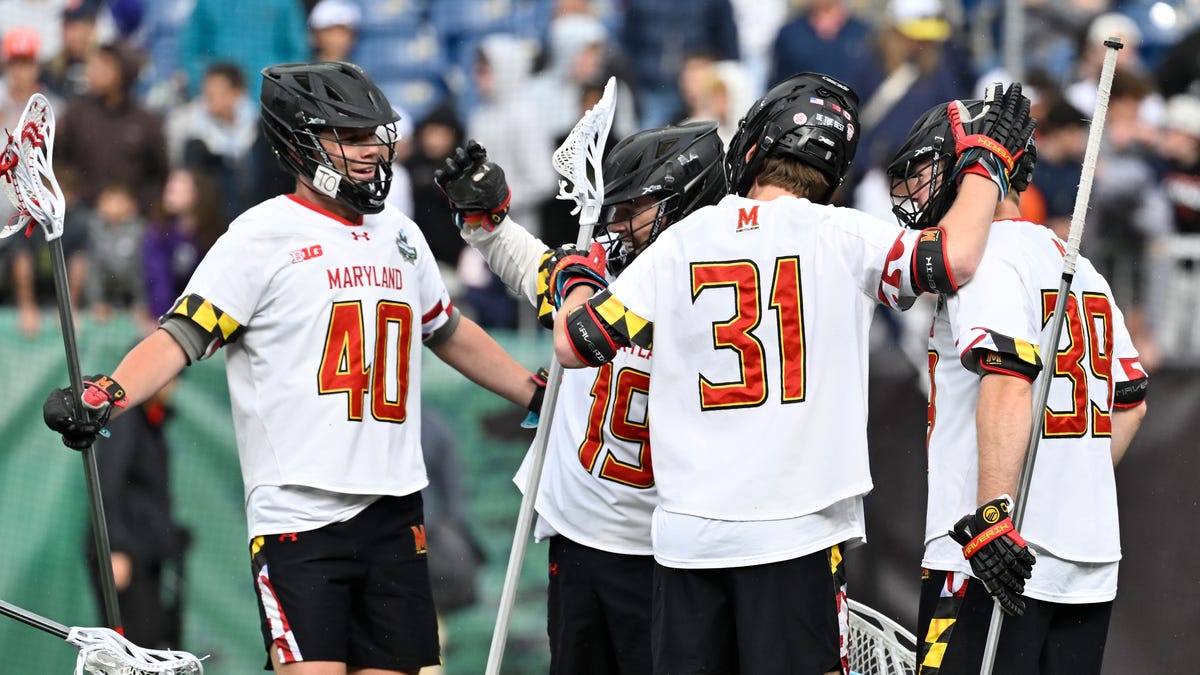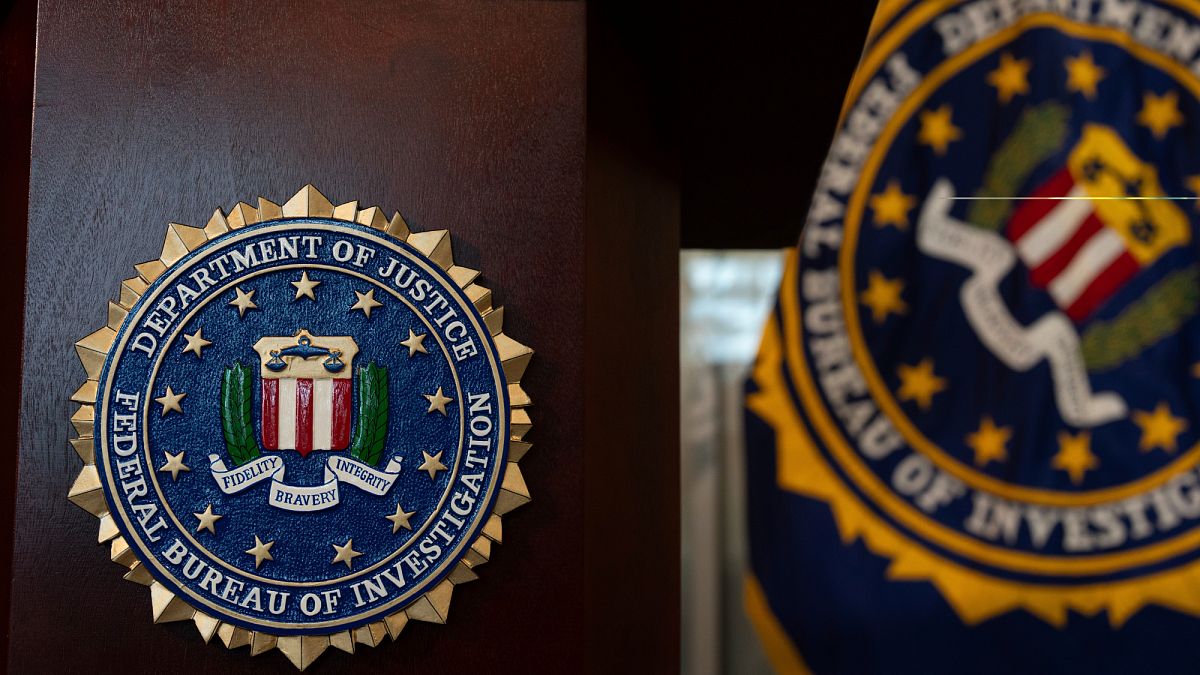Science
Despite warnings from bird flu experts, it's business as usual in California dairy country
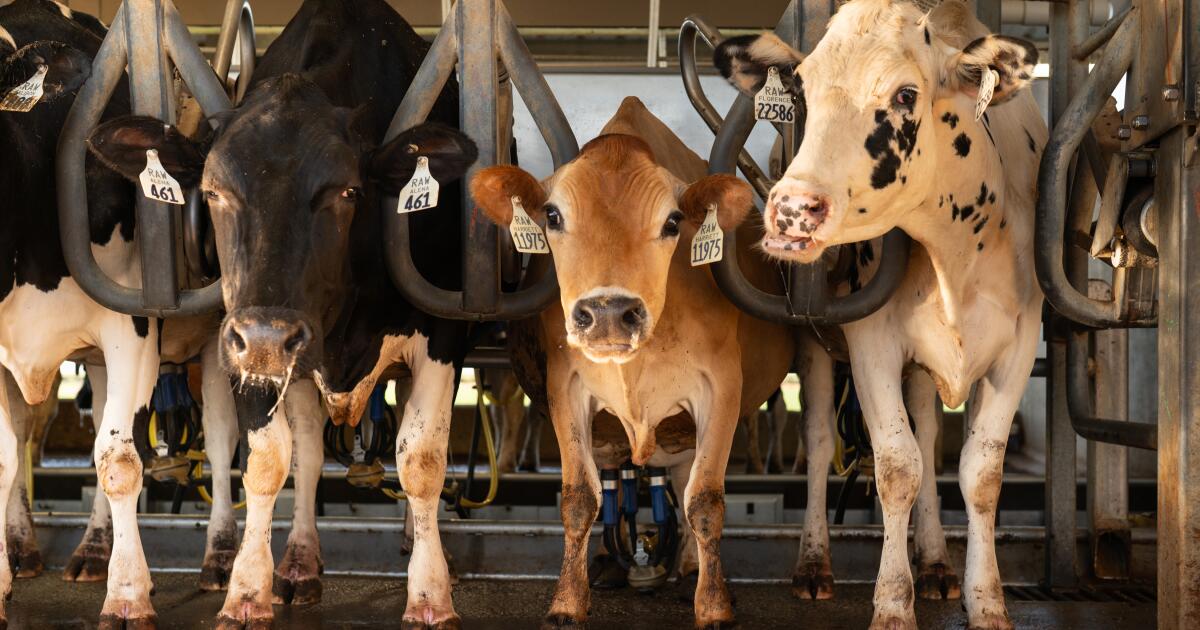
TIPTON, Calif. — It was a late fall morning and hundreds of cows — black and white splattered Holsteins and cappuccino-colored Jerseys — milled about a San Joaquin Valley dairy farm in the largest milk-producing state in the nation.
Nearby, workers herded some of the animals onto a rotating platform within the farm’s milking parlor and quickly attached pumping equipment. The machines buzzed and whirred as the cows were carried in a lazy arc to the parlor’s exit, where they were detached from milk hoses and sent on their way.
The scene seemed utterly unremarkable — except for the fact that five days earlier, the H5N1 bird flu virus that has ravaged California’s dairy herds for the last three months, had been confirmed on the farm. Although dozens of cows were sick, and their owner expected that number to climb, none of the farm’s workers wore personal protective equipment and vehicles from off site were let in and out with nary a hint of concern.
As H5N1 bird flu infects a growing number of California dairy farms, dead cows are becoming an increasingly common site in some areas of the Central Valley.
(Tomas Ovalle / For The Times)
The farm was just one of more than 400 California operations that have been confirmed to have suffered outbreaks of H5N1, but interviews with Central Valley dairy farmers, dairy workers and a recent study by the U.S. Centers for Disease Control and Prevention suggests the virus may be more widespread in people than the CDC’s official numbers suggest. Although authorities have been urging dairy farms and workers to take precautions against spreading infection, there is little evidence their cautions are being heeded.
No expert will say that H5N1 bird flu is going to become the next global pandemic, and government health officers say the virus poses a low risk to the public. However, some experts warn that nearly all the conditions needed for the virus to develop a threatening mutation are now present in many dairy farms: Lax testing protocols; close, unprotected contact between humans and animals; a general failure to take the threat seriously enough; and the approach of human flu season.
Since this particular clade of H5N1 virus (2.3.4.4b) first appeared in North America at the end of 2021, it has infected more than 600 dairy herds across 15 states, hundreds of millions of wild and domesticated birds, and at least 48 mammal species — such as dolphins, seals, cats and dogs.
“We are in a soup of virus. I mean, there’s virus everywhere around us at this point,” said Dr. Marcela Uhart, a wildlife veterinarian with UC Davis’ One Health institute, who is based in Argentina, speaking at symposium held by the O’Neill Institute at Georgetown Law recently. (11/15) “This virus is circulating left and right in mammals and in birds, as far as we can tell, some of them are not showing any signs of disease.”
In October, The Times visited Tipton, a dairy town in Tulare County, and spoke with several residents, including Elodia Ibañez, who said the number of reported human cases in California — which in mid-October was 16, and is now 23 — sounded too low. She said her husband, a dairy worker, told her that two of his co-workers had red, swollen eyes, but they had continued working despite displaying bird flu symptoms.
“It’s an illness that they know the cows have, and many cows have died. But the boss cared about the cows, not the workers,” Ibañez told The Times. “They never told them they have to go to the doctor to get a check-up.”
People often continue to work because they feel they have no other choice, she said. “Even though they say there are laws that protect them, there are still a lot of people who are fearful … They’re scared of losing their jobs.”
Anthony, also a Tipton resident, said he would talk, but did not want to share his last name; he has family members who work in dairies, and he feared impacting their employment by speaking out.
“My dad and uncle have told me there’s a bunch of dairies that have had outbreaks,” Anthony said. He said his dad and uncle take steps to stay safe, but many workers likely are not reporting getting sick because they don’t want to get in trouble.
“Some of them are here not legally. They’re relying on that job, they don’t want to jeopardize that,” he said.
In early November, the CDC published a study that looked for H5N1 antibodies in the blood of dairy workers in Michigan and Colorado. The agency sampled blood from 115 people; eight — or 7% — had antibodies. Only three dairy workers in those two states — one in Colorado, two in Michigan — have been positively identified as having the disease.
It’s this blindness to — and ignorance of — the virus’ reach that has infectious disease and health experts concerned.
And as human flu season approaches, and infected wild birds continue their southward migration down the North American flyways — stopping to rest in lakes, ponds, farms and backyards throughout the United States — experts worry conditions are becomingly increasingly ripe for a large “spillover” event.
If a virus — whether it’s a bird flu, a human influenza virus or a coronavirus — is given the opportunity to spread within and between organisms, the virus will evolve, adapt and mutate. Sometimes these mutations have little effect on its ability to transmit between organisms or cause severe disease. But sometimes, they do.
Then there’s the concern that the bird flu virus will find another flu virus that’s circulating — a human, swine or even other bird flu — and swap genetic material with it, potentially creating a new “super flu” that can spread easily between people, make its hosts very sick, or carry immunity to the antiviral medications used to treat infected patients.
In the 1970s, when the understanding of flu viruses was still being developed, Robert Webster, a researcher at St. Jude’s Hospital in Memphis, Tenn., conducted an experiment at the U.S. Department of Agriculture’s Plum Island Research Station, off the coast of Long Island.
He put a human flu virus — H3N2 — into one pig, and a swine flu virus — H1N1 — into another. He then put the two pigs in a pen with four other pigs. Seven days later, he and his team detected reassorted viruses — H3N1 and H1N2 — in one of the other pigs.
The viruses had swapped genes and created new combinations.

Jersey cows drink water at sunrise.
(Tomas Ovalle / For The Times)
The work of Webster and others led to the discovery that several of the nastier historical flu pandemics have been the result of this kind of reassortment. For instance, the 1918 flu outbreak — which killed approximately 50 million people worldwide — is believed to have been a recombined version of a bird and human flu.
It happened again in 2009, when a human and swine flu switched genes, unleashing the H1N1 swine flu outbreak that killed roughly 500,000 people.
Already there is evidence this virus is swapping genes. The birds currently traveling south from the Arctic are carrying a slightly different variant of H5N1 — called D1.1 or D1.2 — that has an altered take on the several of the flu’s viral segments.
It’s this strain that has put a Canadian teenager into critical condition at a British Columbia hospital. Health authorities don’t know where or how the child picked it up, except to note it wasn’t from cows or poultry. And they don’t know yet whether it has acquired the ability to move easily between people — although early and initial testing suggests it may have acquired some new and ominous traits, including changes that would make it easier to infect people.
Even so, as of this moment, there is no evidence that the H5N1 bird flu circulating among dairy cows and workers — known as B3.13 — has achieved the ability to move efficiently from human to human, or to cause severe illness. But with human flu season approaching — and the possibility that retail customers were drinking infected raw milk — the chances increase.
In an effort to spread awareness among dairy farms and potentially lure workers in for testing and decrease the chances for this virus to acquire mutations that could make it widespread and deadly in people, state health, agriculture and workers safety experts held a workshop at the Tulare Expo Center in late October, with help from the dairy trade group, Western United Dairies.
About 20 dairy workers and farmers sat through the two-hour session, which included English and Spanish presentations from the different state agenciess and dozens of slides
Dr. Erica Pan, California’s State Epidemiologist, told the audience her agency recommended personal protective equipment at work, and urged people to protect their eyes. She also told the audience to stay up to date on their recommended vaccines and refrain from consuming raw milk and undercooked beef, “especially ground beef.”
Eric Berg, Deputy Chief of Health and Research and Standards at CalOSHA said that farms under quarantine needed to establish restricted areas for infected animals. Workers, he said, should wear protective clothing, including coveralls, gloves and “and very important … eye protection and also respirators indoors.”
Eduardo Mondragon sat near the front of a conference room, nodding along as experts discussed safety protocols for dairy workers. As a manager of multiple dairy farms, Mondragon had watched the bird flu rip through the farms he oversaw in Tulare County and the cows he and his colleagues were tasked with caring for as they became sick.
Milk production fell as hundreds of cows became sick and about a dozen died, he said, but the dairy’s owner provided protective gear, including gloves and goggles, which workers were used to wearing daily.
At the dairy farm, Mondragon said they worked quickly when cows started getting sick over the summer to try and stop the spread. His boss sent him to the seminar in Tulare to learn more about the bird flu.
“For weeks, we never stopped,” he said, with many workers working weekend shifts to care for the cows. “We had a good handle on the flu, and because of that we didn’t suffer that many losses. Milk production yes, but animals, no.”
Mondragon knows that while his dairy farm saw the worst of the bird flu hit over the summer, none of the workers reported getting sick. He said friends in the industry in other countries were not yet affected like dairies in Tulare County.
After the seminar, Mondragon loaded up his white pickup truck with boxes of N95 masks, face shields and goggles to take back to his job site and share with the other workers.

Science
Only a fraction of fire cleanup workers are protecting themselves against toxic debris. One community center is fighting to change that

A crew of 10, many sporting bright orange National Day Laborer Organizing Network T-shirts, funneled out of a Mexican restaurant on the edge of the Eaton burn scar.
Four months — to the day — after winds smashed a tree into a car next to NDLON’s Pasadena Community Job Center and soot blanketed the neighborhood, a University of Illinois Chicago professor, NDLON staff and volunteers sorted into cars under the midday sun and began discreetly traveling every road in fire-stricken Altadena.
-
Share via
They watched nearly 250 crews — working long hours (for good pay), many under contract with the U.S. Army Corps of Engineers — remove the toxic debris covering the landscape in the wake of the fire.
Of the over 1,000 workers they surveyed in the burn area on May 7 and 9, only a quarter wore gloves, a fifth wore a protective mask, and a mere tenth donned full Tyvek suits, as required by California’s fire cleanup safety regulations, the group’s report, released Thursday, found.
For Pablo Alvarado, co-executive director and co-founder of NDLON, the results aren’t surprising.
NDLON — a Pasadena-based, national network of day laborer organizations, focused on improving the lives of day laborers, migrant and low-wage workers — has been responding to post-disaster worker safety issues for decades. Alvarado couldn’t help but remember the laborers he and NDLON supported during the cleanup following 9/11 over 20 years ago.
“Those workers are no longer alive. They died of cancer,” he said. “These are workers I’d known for decades — their sons, their cousins.”

Smoke rises from the burning twin towers of the World Trade Center after hijacked planes crashed into the towers, Sept. 11, 2001, in New York.
(Richard Drew / Associated Press)
As Alvarado watches a new generation of laborers get to work in the aftermath of the L.A. fires, his call to action is simple: “I just don’t want to see people dying.”
“We are committed to protecting all workers, regardless of immigration status,” a California Department of Industrial Relations spokesperson said in a statement to The Times.
The Department of Industrial Relations houses the Cal/OSHA program, which is responsible for enforcing worker safety requirements.
“Our outreach services participated in numerous events to ensure safety information is clear, accessible, and widely shared across impacted communities,” the spokesperson said. “Our enforcement team has also been actively providing compliance assistance. To date this team has provided nearly 500 site visits to educate both employers and employees.”
In a statement to The Times, the Army Corps said it mandates every corps employee and contractor to wear proper PPE.
“USACE’s number one priority is public health and safety — of our employees and contractors, and of the survivors and the community,” the corps said. “No workers are ever allowed on USACE sites without proper PPE.”
Yet NDLON has seen lax PPE use time and time again following disasters. Since 2001, NDLON has dispatched to countless hurricanes, floods and fires to support what the organization calls the “second responders” — the workers who wade through the rubble and rebuild communities after the devastation. Eaton was no different.
“We always respond around the country to floods, fires, no matter where it is,” said Cal Soto, workers’ rights director for NDLON, who helped survey workers in the burn area. For the Eaton fire, “we just happen to be literally in the shadow of it.”
When wildfires push into developed areas like Altadena, they chew through not just trees but also residents’ cars, plastics, batteries and household goods such as detergents and paint thinners, releasing hosts of toxic chemicals.
They include heavy metals such as lead and mercury, capable of damaging the nervous system and kidneys, as well as arsenic and nickel, known carcinogens. Organic materials like wood and oil that don’t fully burn can leave polycyclic aromatic hydrocarbons — or PAHs — which can harm the immune system and cause sickness in the short term and cancer in the long term.
Their primary opportunities to enter the body are through the inhalation of toxic air or through ingestion, after collecting on the hands of a person who then touches their face or uses their hands to eat. They can also, to a lesser extent, absorb directly through the skin.
Masks and disposable head-to-toe coverall suits act as a barrier against the dangerous contaminants.
The responsibility to ensure workers are using those protective barriers on the job ultimately falls on the employer, said Soto.
However, the breakdown of the safety standards can happen anywhere in the chain: The state’s OSHA division can fail to communicate rules to companies and enforce them. Employers can fail to educate their employees or provide the correct PPE. Workers themselves — despite it all — can choose to remove their PPE on long, hot days where a plastic suit and heavy duty mask feel suffocating.
“Sometimes it’s uncomfortable to wear all of that crap — particularly when it’s hot,” said Alvarado, who was a day laborer before founding NDLON. “Sometimes you feel like you’re suffocated.”
NDLON and its Pasadena Community Job Center, within hours of the Eaton fire, became a hub for the community’s response. Its volunteers handed out PPE, food and donations to workers and community members. By the end of January, it had hundreds of helping hands clearing Pasadena’s parks and streets of debris to assist overwhelmed city employees.
At the same time, day labor, construction and environmental remediation workers quickly rushed into the burn zone along with the donations, media attention and celebrities. Like clockwork, so did the labor safety violations.
How to keep a worker safe
In a dimly lit Pasadena church in late January, dozens of day laborers watched as Carlos Castillo played the role of an impatient boss, barking directions at three workers standing before them.
“Hurry up,” Castillo told them in Spanish, handing out boxes of protective suits and masks. One woman, standing in front of the room, fumbled with the straps of a respirator.
Debora Gonzalez, health and safety director NDLON, eyed the day laborer’s efforts before asking the crowd: “What is our friend missing?”
“Gloves!” someone called out.
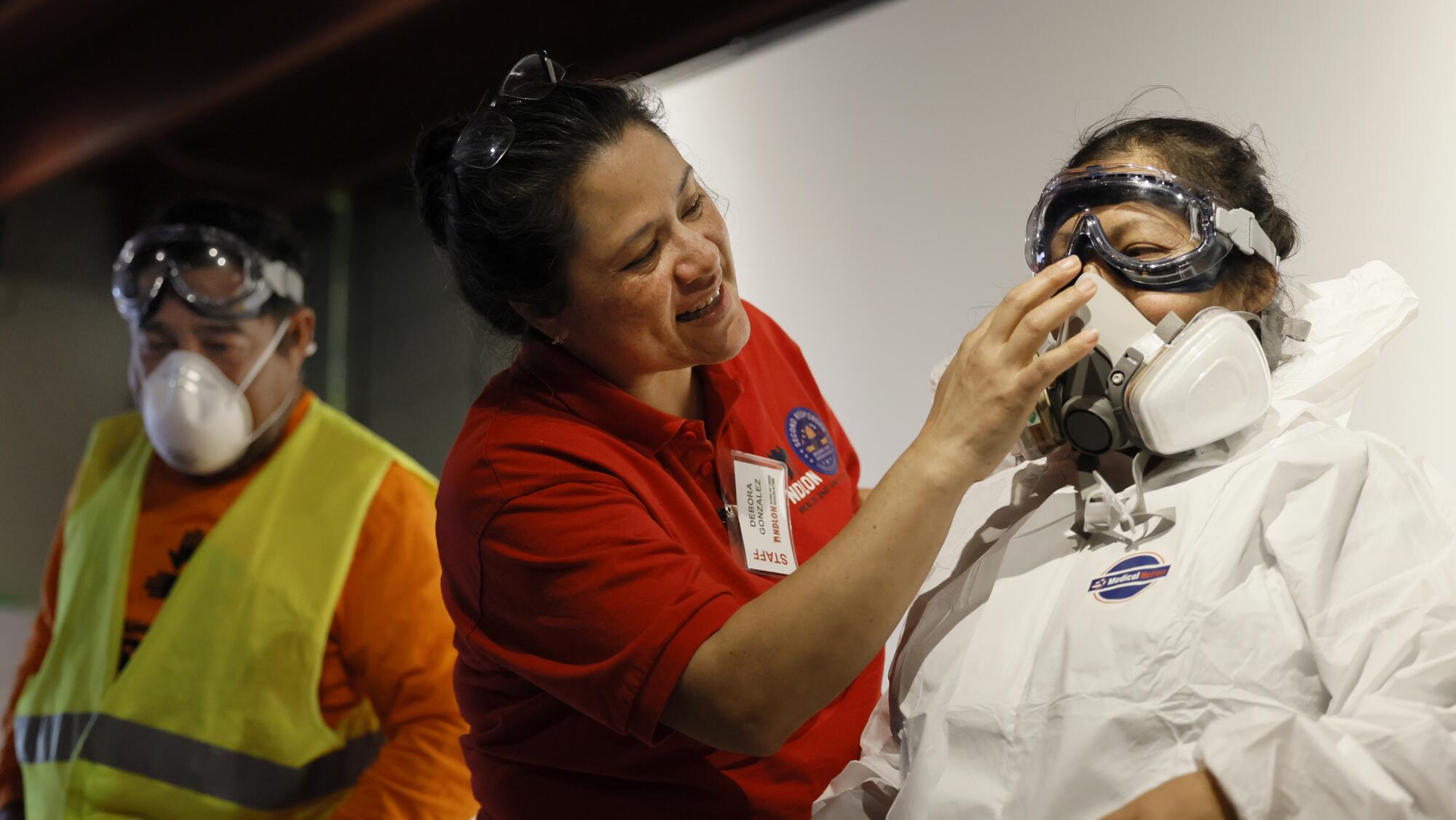
Debora Gonzalez, middle, teaches fire cleanup workers safety training such as proper fitting and use of a respirator and proper wearing of protective clothing for cleaning disaster sites through the National Day Laborer Organizing Network in Pasadena on Jan. 31.
(Allen J. Schaben / Los Angeles Times)
Gonzalez and other volunteers called on the crowd, who quickly pointed out more problems with the equipment that the three workers had hastily donned. One had a mask that wasn’t sufficient for toxic cleanup; Gonzalez also pointed out that his beard would allow dust to infiltrate.
Castillo, a volunteer trainer and president of the D.C.-based immigrant worker-support nonprofit Trabajadores Unidos de Washington D.C., reminded them that when they are cleaning up an area after a wildfire, there could be a range of noxious chemicals in the ash. Gonzalez said she wanted them to be prepared.
“Tomorrow we’ll practice again,” she told them.
NDLON set up the free trainings for any day laborers interested in supporting fire recovery after some laborers began picking up work cleaning homes contaminated with smoke and ash near the fire zones.
Employers are supposed to provide protective equipment to workers and train them on how to use it, but “many times employers want to move quickly. They just want to get the job done and get the job done as quickly as possible,” said Nadia Marin-Molina, NDLON co-executive director. “Unfortunately, workers’ health goes by the wayside.”
As NDLON worked to educate day laborers, another group of workers moved in: The Army Corps of Engineers’ contractors and private debris removal crews. Alvarado quickly noticed that many of the corps’ workers were not wearing the required PPE.
Never one to let the “Day Laborer” in NDLON’s name limit his compassion, Alvarado reached out to a longtime collaborator, Nik Theodore, a University of Illinois Chicago professor who studies labor standards enforcement, to do something about it.
Neglected in the burn zone
A week later, Juan Pablo Orjuela, a labor justice organizer with NDLON, made sure the air was recirculating in the car as the team drove through the burn zone, surveying workers for the NDLON and University of Illinois Chicago report in early May. He watched an AllTrails map documenting their progress — they’d drive until they had traced every street in northeast Altadena.
Orjuela spotted an Army Corps crew working on a home and pulled the car to the curb. “Eight workers — no gloves, no Tyvek suit,” he said.
Nestor Alvarenga, a day laborer and volunteer with NDLON, sat in the back, tediously recording the number of workers, how many were wearing protective equipment and the site’s address into a spreadsheet on an iPad with a beefy black case.
The Army Corps said it requires all workers on-site to wear a hard hat, safety glasses and reflective vests. Workers in the ash footprint must also wear Tyvek suits, gloves and a respirator, the corps said.
One worker walked up to the car; Orjuela slowly lowered the window.
“Do you guys need anything?” the worker asked.
“No, we’re OK,” Orjuela said, “we’ll get out of your way.”

Debora Gonzalez, left, teaches fire cleanup workers safety training such as proper fitting and use of a respirator and proper wearing of protective clothing for cleaning disaster sites through the National Day Laborer Organizing Network in Pasadena on Jan. 31.
(Allen J. Schaben / Los Angeles Times)
Orjuela rolled up the window and pulled away. “I don’t really have to tell anybody what I’m doing,” he said. “I’m not being antagonistic, but you know … I’m just not saying anything to anybody.”
Theodore and NDLON hope the window survey, spanning 240 job sites with more than 1,000 total workers, can raise awareness for safety and health concerns in the burn areas, help educate workers, and put pressure on the government to more strictly enforce compliance.
“This was no small sample by any means,” Theodore said. “This was an attempt to be as comprehensive as possible and the patterns were clear.”
For Soto, the results are a clear sign that, first and foremost, employers are not upholding their responsibility to ensure their workers’ safety.
“It’s the responsibility of the employer,” he said. “I want to be clear that we have that expectation — that demand — always.”
Yet the window survey found even job sites where the PPE requirements are explicitly listed by the employer on a poster at the site, usage was still low. The reality, NDLON organizers said, is that the state must step in to help enforce the rules.
“I understand that the disaster was colossal, and I never expected the government to have the infrastructure to respond immediately,” said Alvarado, “but at this point, making sure workers have PPE, that’s a basic thing that the government should be doing.”
Former Times staff writer Emily Alpert Reyes contributed to this report.
Science
Trump cuts will cause a spike in HIV cases in L.A. and across the country, warn Democrats and public health advocates

A growing coalition of HIV prevention organizations, health experts and Democrats in Congress are sounding the alarm over sweeping Trump administration cuts to HIV/AIDS prevention and surveillance programs nationally, warning they will reverse years of progress combating the disease and cause spikes in new cases — especially in California and among the LGBTQ+ community.
In a letter addressed Friday to Health and Human Services Secretary Robert F. Kennedy Jr., Rep. Laura Friedman (D-Glendale) and 22 of her House colleagues demanded the release of HIV funding allocated by Congress but withheld by the Trump administration. They cited estimates from the Foundation for AIDS Research, known as amfAR, that the cuts could lead to 143,000 additional HIV infections nationwide and 127,000 additional deaths from AIDS-related causes within five years.
Friedman said the effects would be felt in communities small and large across the country but that California would be hit the hardest. She said L.A. County — which stands to lose nearly $20 million in annual federal HIV prevention funding — is being forced to terminate contracts with 39 providers and could see as many as 650 new cases per year as a result.
According to amfAR, that would mark a huge increase, pushing the total number of new infections per year in the county to roughly 2,000.
“South L.A. and communities across California are already feeling the devastating impacts of these withheld HIV prevention funds. These cuts aren’t just numbers — they’re shuttered clinics, canceled programs, and lives lost,” Friedman said in a statement to The Times.
As one example, she said, the Los Angeles LGBT Center — which is headquartered in her district — would likely have to eliminate a range of services including HIV testing, STD screening, community education and assistance for patients using pre-exposure prophylaxis, or PrEP, a medicine taken by pill or shot that can greatly reduce a person’s risk of becoming infected from sex or injection drug use.
A list reviewed by The Times of L.A. County providers facing funding cuts included large and small organizations and medical institutions in a diverse set of communities, from major hospitals and nonprofits to small clinics. The list was provided by a source on the condition of anonymity in order to be candid about the funding of organizations that have not all publicly announced the cuts.
The affected organizations serve a host of communities that already struggle with relatively high rates of HIV infection, including low-income, Spanish speaking, Black and brown and LGBTQ+ communities.
According to L.A. County, the Trump administration’s budget blueprint eliminates or reduces a number of congressionally authorized public health programs, including funding cuts to the domestic HIV prevention program and the Ryan White program, which supports critical care and treatment services for uninsured and underinsured people living with HIV.
The county said the cuts would have “an immediate and long-lasting impact” on community health.
Dozens of organizations and hospitals, such as Children’s Hospital of Los Angeles, are bracing for the disruption and potential vacuum of preventative services they’ve been providing to the community since the 1980s, according to Claudia Borzutzky, the hospital’s Chief of Adolescent and Young Adult Medicine.
Borzutzky said without the funding, programs that provide screening, education, patient navigation and community outreach — especially for at-risk adolescents and young adults — will evaporate. So, too, will free services that help patients enroll in insurance and access HIV prevention medications.
Patients who “face a variety of health barriers” and are often stigmatized will bear the brunt, she said, losing the “role models [and] peer educators that they can relate to and help [them] build confidence to come into a doctor’s office and seek testing and treatment.”
“We are having to sunset these programs really, really quickly, which impacts our patients and staff in really dramatic ways,” she said.
Answers to queries sent to other southern California health departments suggested they are trying to figure out how to cope with budget shortfalls, too. Health officials from Kern, San Bernardino and Riverside counties all said the situation is uncertain, and that they don’t yet know how they will respond.
Friedman and her colleagues — including fellow California representatives Nancy Pelosi, Judy Chu, Gilbert Cisneros Jr., Robert Garcia, Sam Liccardo, Kevin Mullin, Mark Takano, Derek Tran and George Whitesides — said they were concerned not only about funding for programs nationwide being cut, but also about the wholesale dismantling or defunding of important divisions working on HIV prevention within the federal government.
They questioned in their letter staffing cuts to the National Center for HIV, Viral Hepatitis, STD, and Tuberculosis Prevention at the U.S. Centers for Disease Control and Prevention, as well as “the reported elimination” of the Division of HIV Prevention within that center.
In addition to demanding the release of funds already allocated by Congress, the representatives called on Kennedy — and Dr. Debra Houry, deputy director of the CDC — to better communicate the status of ongoing grant funding, and to release “a list of personnel within CDC who can provide timely responses” when those groups to whom Congress had already allocated funding have questions moving forward.
“Although Congress has appropriated funding for HIV prevention in Fiscal Year 2025, several grant recipients have failed to receive adequate communication from CDC regarding the status of their awards,” Friedman and her colleagues wrote. “This ambiguity has caused health departments across the country to pre-emptively terminate HIV and STD prevention contracts with local organizations due to an anticipated lack of funding.”
The letter is just the latest challenge to the Trump administration’s sweeping cuts to federal agencies and to federal funding allocated by Congress to organizations around the country.
Through a series of executive orders and with the help of his billionaire adviser Elon Musk’s “Department of Government Efficiency” and other agency heads, Trump in the first months of his second term has radically altered the federal government’s footprint, laying off thousands of federal workers and attempting to claw back trillions of dollars in federal spending — to be reallocated to projects more aligned with his political agenda, or used to pay for tax cuts that Democrats and independent reviewers have said will disproportionately help wealthy Americans.
California Atty. Gen. Rob Bonta’s office has repeatedly sued the Trump administration over such moves, including cuts and layoffs within Health and Human Services broadly and cuts to grants intended to make states more resistant to infectious disease specifically — calling them unwise, legally unjustifiable and a threat to the health of average Americans.
LGBTQ+ organizations also have sued the Trump administration over orders to preclude health and other organizations from spending federal funding on diversity, equity and inclusion programs geared toward LGBTQ+ populations, including programs designed to decrease new HIV infections and increase healthy management of the disease among transgender people and other vulnerable groups.
“The orders seek to erase transgender people from public life; dismantle diversity, equity, inclusion, and accessibility initiatives; and strip funding from nonprofits providing life-saving health care, housing, and support services,” said Jose Abrigo, the HIV Project Director of Lambda Legal, in a statement. The legal group has filed a number of lawsuits challenging the Trump administration cuts, including one on behalf of the San Francisco AIDS Foundation and other nonprofits.
Trump has defended his cuts to the federal government as necessary to implement his agenda. He and his agency leaders have consistently said that the cuts target waste, fraud and abuse in the government, and that average Americans will be better served following the reshuffling.
Kennedy has consistently defended the changes within Health and Human Services, as well. Agency spokespeople have said the substantial cuts would help it focus on Kennedy’s priorities of “ending America’s epidemic of chronic illness by focusing on safe, wholesome food, clean water, and the elimination of environmental toxins.”
“We aren’t just reducing bureaucratic sprawl. We are realigning the organization with its core mission and our new priorities in reversing the chronic disease epidemic,” Kennedy has said. “This Department will do more — a lot more — at a lower cost to the taxpayer.”
Kennedy has repeatedly spread misinformation about HIV and AIDS in the past, including by giving credence to the false claim that HIV does not cause AIDS.
As recently as June 2023, Kennedy told a reporter for New York Magazine that there “are much better candidates than H.I.V. for what causes AIDS,” and he has previously suggested that environmental toxins and “poppers” — an inhalant drug popular in the gay community — could be causes of AIDS instead.
None of that is supported by science or medicine. Studies from around the world have proven the link between HIV and AIDS, and found it — not drug use or sexual behavior — to be the only common factor in AIDS cases.
Officials in L.A. County said they remained hopeful that the Trump administration would reverse course after considering the effects of the cuts — and the “detrimental impacts on the health and well-being of residents and workers across” the county if they are allowed to stand.
Science
Fertility clinic director vows to rebuild after Palm Springs bombing. 'Life is preserved'

PALM SPRINGS — Less than a week after a targeted bomb explosion nearly destroyed his fertility clinic, Dr. Maher Abdallah stood below the blazing desert sun in front of a liquor store, its windows blown out by the powerful blast. Behind him was what remained of American Reproductive Centers.
The clinic — the Coachella Valley’s only full-service fertility center and IVF lab, according to its website — had been relegated to a crime scene. All four buildings will need to be demolished and replaced, a process that could take up to two years, he said. Still, he dismissed the destruction as “material loss.”
In what Abdallah described as a series of miracles, nobody was in the clinic last Saturday morning and its in vitro fertilization lab remained intact despite the mighty force of the explosion. The attack knocked out the electricity that powered the facility’s incubators and damaged the backup generator, but emergency responders rushed in to address the outage and ensure that the thousands of frozen eggs, sperm and embryos stored in cryogenic tanks went unharmed.
He later learned that of the 14 embryos that were dividing in incubators at the time of the attack — all belonging to one same-sex couple — eight had become “perfect blastocysts,” or balls of cells that form early in pregnancy.
Saturday’s bomb blast in Palm Springs caused large portions of the American Reproductive Centers facility to collapse.
(Allen J. Schaben / Los Angeles Times)
“My return on the investment is babies,” said Abdallah, whose clinic claims to have helped more than 2,000 couples grow their families, many of them in the region’s LGBTQ+ community. “Life is preserved, and that’s really all I care about.”
The bomb that detonated at the fertility clinic in this resort city last Saturday injured four people and killed the suspected bomber, 25-year-old Guy Edward Bartkus, who lived about an hour away in Twentynine Palms. The FBI has labeled the incident as domestic terrorism.
FBI case investigators, as well as law enforcement sources, characterize Bartkus as having “antinatalist” ideations, a conclusion drawn from social media posts and other online materials authorities have linked to him. In those public posts, he argued that procreation without the consent of the unborn is unethical and unjustifiable in a world struggling with environmental harm, violence and overpopulation. In addition, the posts indicate he was mourning the recent death of a friend.
A website that authorities link to Bartkus laid out the case for “a war against pro-lifers” and said a fertility clinic would be targeted. “Basically, I’m a pro-mortalist,” the author wrote, referring to a fringe philosophical position that it is best for sentient beings to die as soon as possible to prevent future suffering.
At a news conference Thursday, Abdallah told the throng of local officials and reporters gathered that he forgave the suspect and had instructed his staff not to talk about him.
When asked about the bomber’s ideology, Abdallah said simply that he was “for life” and didn’t care to weigh in further. The only reference to the suspect came from Abdallah’s business partner, who said the doctor had requested he reach out to Bartkus’ family and offer to pay for his funeral services.
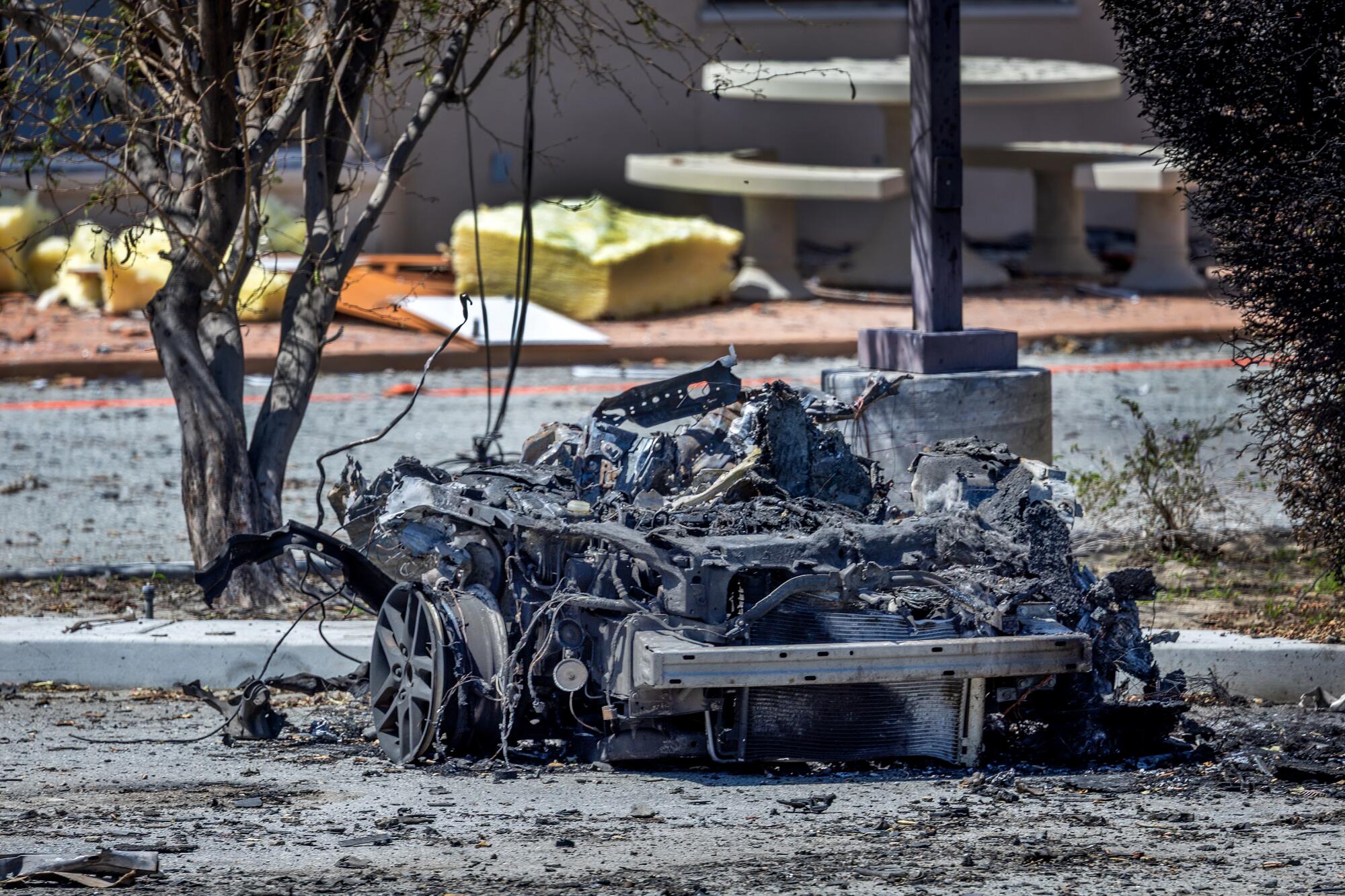
The remains of the car used in Saturday’s bomb attack sit in a twisted pile outside the American Reproductive Centers in Palm Springs.
(Allen J. Schaben / Los Angeles Times)
Instead, Abdallah said he has turned his focus to the future. Just days after the bombing, the clinic was offering basic ultrasounds at another medical office. Next week, American Reproductive Centers will temporarily relocate to a surgical center across the street.
Abdallah vowed to rebuild the clinic on the same site in uptown Palm Springs, across from the local hospital. The facility was well-secured, he said, with cameras on every corner and facing the chained cryogenic equipment. But in the future, he said, he also wants guards to patrol the premises.
“We will rebuild, we will grow, and we will continue to help families grow also,” said Abdallah’s cousin and business partner, Amer Abdallah. “We believe in miracles. We witness them every single day. And no act of hatred can stop us from bringing those miracles into this world.”
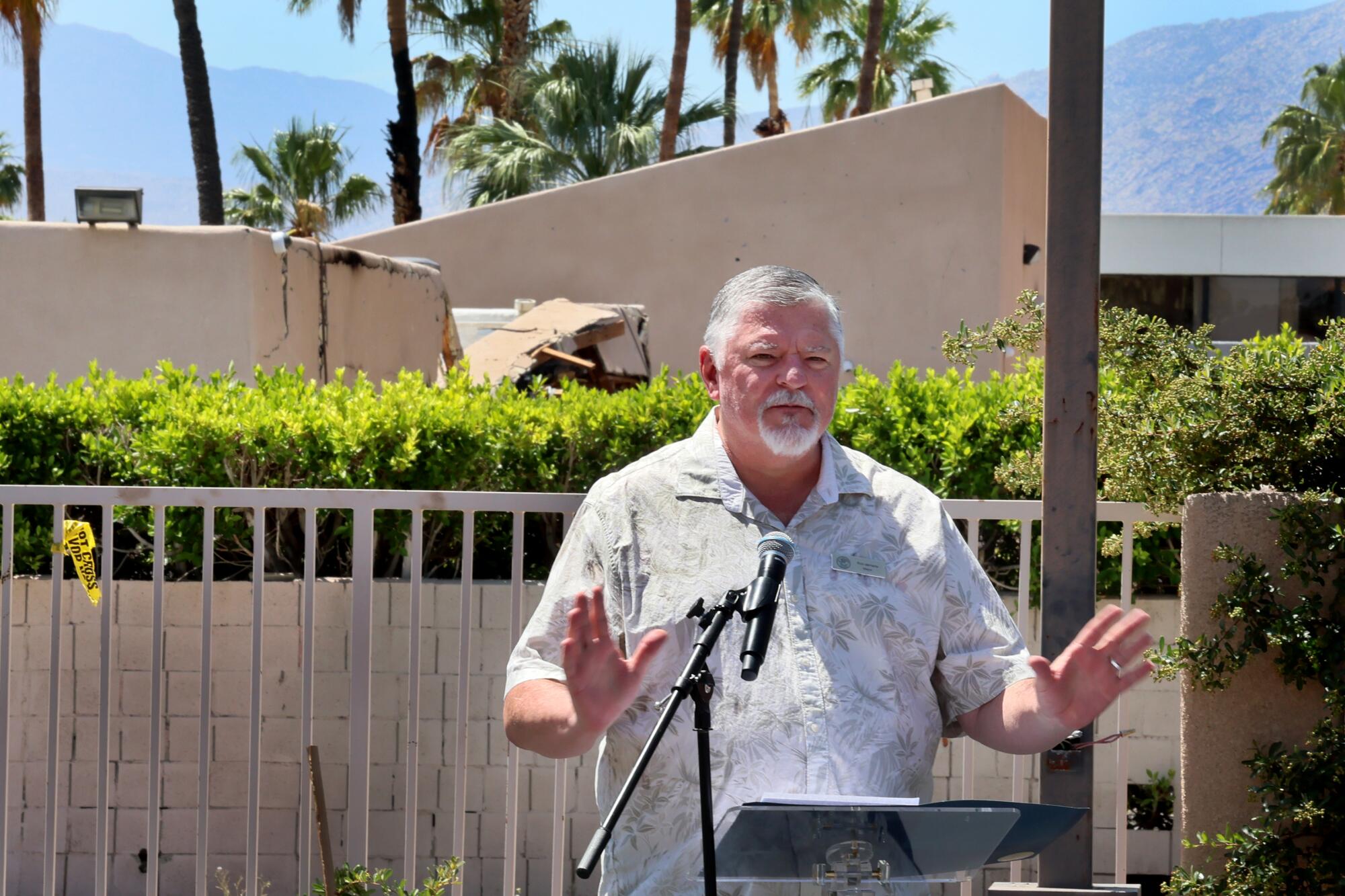
Palm Springs Mayor Ron deHarte said the city is working to bring “every possible resource” to the residents and small businesses affected by the bomb attack at American Reproductive Centers.
(Allen J. Schaben / Los Angeles Times)
Palm Springs Mayor Ron deHarte said the city is working with state, regional and county offices to bring “every possible resource” to the residents and small businesses impacted by the blast, which was reportedly felt more than two miles away and damaged windows and walls in nearby buildings.
He said the City Council would be looking into creating programs to support damaged businesses, including reducing fees for building permits and expediting the processes for obtaining new permits, business licenses and inspections.
“This act,” he said, “will never deter us. Love always triumphs in Palm Springs.”
This article is part of The Times’ equity reporting initiative, funded by the James Irvine Foundation, exploring the challenges facing low-income workers and the efforts being made to address California’s economic divide.
-

 Technology1 week ago
Technology1 week agoLove, Death, and Robots keeps a good thing going in volume 4
-

 Technology1 week ago
Technology1 week agoMeta asks judge to throw out antitrust case mid-trial
-

 World1 week ago
World1 week agoCommissioner Hansen presents plan to cut farming bureaucracy in EU
-

 Movie Reviews1 week ago
Movie Reviews1 week agoClassic Film Review: ‘Mad Max: Fury Road’ is a Lesson in Redemption | InSession Film
-

 News1 week ago
News1 week agoVideo: Doctors Heal Infant Using First Customized-Gene Editing Treatment
-

 Politics1 week ago
Politics1 week agoDem senator says 'no doubt' Biden declined cognitively during presidency
-

 News1 week ago
News1 week agoNew Orleans jailbreak: 10 inmates dug a hole, wrote ‘to easy’ before fleeing; escape plan found
-

 World1 week ago
World1 week agoLeak: Commission to launch PFAS clean-ups in water resilience strategy





